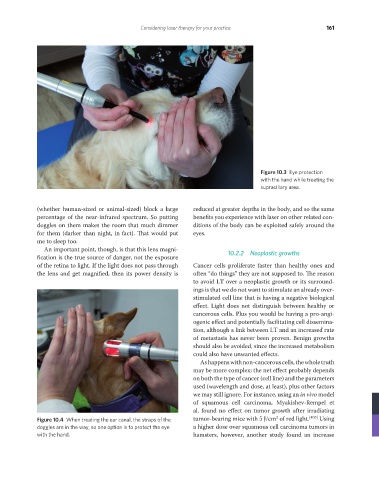Page 175 - Veterinary Laser Therapy in Small Animal Practice
P. 175
Considering laser therapy for your practice 161
Figure 10.3 Eye protection
with the hand while treating the
supraciliary area.
(whether human-sized or animal-sized) block a large reduced at greater depths in the body, and so the same
percentage of the near-infrared spectrum. So putting benefits you experience with laser on other related con-
doggles on them makes the room that much dimmer ditions of the body can be exploited safely around the
for them (darker than night, in fact). That would put eyes.
me to sleep too.
An important point, though, is that this lens magni- 10.2.2 Neoplastic growths
fication is the true source of danger, not the exposure
of the retina to light. If the light does not pass through Cancer cells proliferate faster than healthy ones and
the lens and get magnified, then its power density is often “do things” they are not supposed to. The reason
to avoid LT over a neoplastic growth or its surround-
ings is that we do not want to stimulate an already over-
stimulated cell line that is having a negative biological
effect. Light does not distinguish between healthy or
cancerous cells. Plus you would be having a pro-angi-
ogenic effect and potentially facilitating cell dissemina-
tion, although a link between LT and an increased rate
of metastasis has never been proven. Benign growths
should also be avoided, since the increased metabolism
could also have unwanted effects.
As happens with non-cancerous cells, the whole truth
may be more complex; the net effect probably depends
on both the type of cancer (cell line) and the parameters
used (wavelength and dose, at least), plus other factors
we may still ignore. For instance, using an in vivo model
of squamous cell carcinoma, Myakishev-Rempel et
al. found no effect on tumor growth after irradiating
2
Figure 10.4 When treating the ear canal, the straps of the tumor-bearing mice with 5 J/cm of red light. [403] Using
doggles are in the way, so one option is to protect the eye a higher dose over squamous cell carcinoma tumors in
with the hand. hamsters, however, another study found an increase
REDONDO PRINT (4-COL BLEED).indd 161 08/08/2019 09:48

